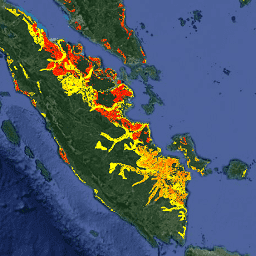
- 数据集可用性
- 1992-01-01T00:00:00Z–2018-01-01T00:00:00Z
- 数据集提供商
- FAO UN
- 频率
- 1 年
- 标签
说明
关于排水有机土壤的两个相关粮农组织数据集提供了以下估计值:
DROSA-A:为农业活动(耕地和放牧草地)而排水的有机土壤面积(公顷)
DROSE-A:这些土地利用类型下有机土壤农业排水的碳 (C) 和一氧化二氮 (N2O) 估计值(以千兆克为单位)。
年度数据以 0.0083333 X 0.0083333 分辨率(赤道附近约为 1 公里)提供,覆盖 1992 年至 2018 年的全球范围。
FAOSTAT 估计值遵循政府间气候变化专门委员会 (IPCC) 的指南,并使用组织壤作为有机土壤存在的代理变量,使用年度土地覆盖地图作为时间相关分量。此外,分析中还会应用土壤特征、土地利用和气候信息。碳排放量可以转换为二氧化碳,只需将像素值乘以二氧化碳 (CO2) 的分子量与碳 (C) 的分子量之比 (44/12) 即可。
有机土壤在潮湿的土壤生态系统中形成。它们包括热带和北方泥炭地、高纬度沼泽、蕨类植物和沼泽地。有机土壤仅占全球陆地面积的 3%,但却占土壤总碳量的 30%,因此在维持地球碳平衡方面发挥着重要作用。农业是导致全球有机土壤排水的主要原因。排水会使有机土壤的有机物暴露在好氧条件下,从而氧化并向大气中释放大量有害的温室气体 (GHG)。
DROSA-A 和 DROSE-A 是 FAOSTAT 三个数据集(有机土壤耕作;耕地;草地)中有关排水有机土壤的国家和地区统计数据的基础。
频段
像素尺寸
927.67 米
频段
| 名称 | 单位 | 像素尺寸 | 说明 |
|---|---|---|---|
croplandc |
Gg | 米 | 农田有机土壤的碳排放量 |
croplandn2o |
Gg | 米 | 农田有机土壤的一氧化二氮排放量 |
grasslandc |
Gg | 米 | 草地有机土壤的碳排放量 |
grasslandn2o |
Gg | 米 | 草地有机土壤的 N2O 排放量 |
使用条款
使用条款
联合国粮食及农业组织 (FAO) 的职责是收集、分析、解读和传播与营养、粮食和农业相关的信息。为此,粮农组织发布了许多与自身职责相关的主题数据库,并鼓励将这些数据库用于科学和研究目的。根据“统计数据库开放数据许可”设想的开放和共享原则,并根据粮农组织的授权,FAOSTAT(粮农组织关于食品和农业数据的数据库)中关于有机土壤上农业活动产生的温室气体排放量的数据可供用户社区免费使用。
引用
FAO 2020 年。1990 年至 2019 年排水的有机土壤。全球、区域和国家/地区趋势。FAOSTAT Analytical Brief Series No 4,粮农组织,罗马。 http://www.fao.org/3/cb0489en/cb0489en.pdf
Conchedda, G. 和 Tubiello, F. N.: 有机土壤的排水和温室气体排放:使用国家级数据进行验证,Earth Syst. Sci. Data Discuss. doi:10.5194/essd-12-3113-2020, 2020
DOI
使用 Earth Engine 探索
代码编辑器 (JavaScript)
var dataset = ee.ImageCollection('FAO/GHG/1/DROSE_A'); var visualization = { bands: ['croplandc'], min: 0, max: 1, palette: ['yellow', 'red'] }; Map.setCenter(108.0, -0.4, 6); Map.addLayer(dataset, visualization, 'Cropland C emissions (Annual)');
